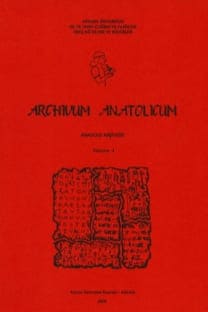Kültepe metinlerinde geçen Himtum kelimesinin anlamı üzerine
Eski Asur Devri metinlerinde anlamı henüz tespit edilememiş veya şüpheli olan birçok kelime bulunmaktadır. Şimdiye kadar birkaç metinde geçmiş olan himtum kelimesinin anlamı üzerinde yeni belgelerden de elde edilen bilgiler doğrultusunda bir değerlendirme yapıldığında; kelimenin gıdalarla kullanılan ṣimdu hacim ölçüsü ile geçmesi, sıklıkla yağlarla birlikte anılan bal ile birlikte kaydedilmesi, “kötü kaliteli” anlamındaki bīšu sıfatı ile nitelenmesi, CCT VI, 6d numaralı metinde himtum ile birlikte sadece yağ çeşitlerinden bahsedilmesi ve makalede değinilen bazı kelimelerin yazılışları arasındaki farklılıkların himtum-himetum ile kıyaslanabilir olması gibi hususlar tespit edilmekte ve daha önceden İ. Albayrak tarafından belirtilen bu iki kelime arasındaki ilişkisinin doğru olduğu sonucuna ulaşmaktayız. Kısaca, himtum, “saf tereyağı” anlamı verilen ve lügatlerde himētum telâffuzu ile kaydedilen himetum’un Eski Asurcadaki yazılışı olmalıdır
Anahtar Kelimeler:
Kültepe, himtum, himētum, saf tereyağı, bal
KÜLTEPE METİNLERİNDE GEÇEN HİMTUM KELİMESİNİN
On the Meaning of Word himtum in the Kültepe Texts In the Old Assyrian texts, there are a few words that are not clarified and mostly doubted. Considering an evaluation in the light of the unpublished texts, the meaning of the word himtum that has been recorded only in a limited number of texts; the use of this word along with the foodstuff measurement unit ṣimdu, and its recording with honey which has frequently been used together with oil, and its presentment with the adjective bīšu having a meaning of “bad quality”, the mentioning of various types of oil with himtum in the text CCT VI, 6d, and comparability of the difference in the writings of words mentioned in the article with himtum-himetum, it can be argued that the affinity between himtum-himētum that has been previously asserted by İ. Albayrak, might be strengthened. In short, it is concluded that the word himtum is the Old Assyrian writing of the word which is recorded as himētum meaning “clarified butter” in the lexical material and should be pronounced as himetum
___
- Albayrak 2002: İ. Albayrak, “Kültepe'den Değişik Bir Masraf Listesi”, ArAn 5, 2002, 1-10.
- Barjamovic 2011: G. Barjamovic, A Historical Geography of Anatolia in the Old Assyrian Colony Period, CNIP 38, Copenhagen 2011.
- Erol 2012: H. Erol, “Bir Kültepe Metnine Göre Eski Asur Devrinde Subartu Bölgesi”, DTCF 52-2, 2012, 117-127.
- Hecker 1966: K. Hecker, Die Keilschrifttext der Universitätsbibliotkek Giessen, Giessen 1966.
- Hirsch 1966: H. Hirsch, “Subrum und scheinbar Verwandtes”, AfO 21- 1, 1966, 52-55.
- Kienast 1990: B. Kienast, “Review of Cuneiform texts from Cappadocian tablets in the British museum. Part VI by P. Garelli and D. Collon”, OLZ 85, 1990, 167-171.
- Lewy 1964: H. Lewy, “The Assload, the Sack, and other Measures of Capacity”, RSO 39, 1964, 181-197.
- Ulshöfer 1995: A. M. Ulshöfer, Die altassyrischen Privaturkunden, FAOSB 4, Stuttgart 1995.
- von Soden 1976: W. von Soden, “Review of Cuneiform texts from Cappadocian tablets in the British museum. Pa
- BIN VI F. J. Stephens, Old Assyrian Letters and Business Documents, Babylonian Inscriptions in the Collection of J. B. Nies 6, New Haven 1944.
- CAD The Assyrian Dictionary of the Oriental Institute of the University of Chicago-Chicago 1956vd.
- CDA J. Black - A. George- N. Postgate, A Concise Dictionary of Akkadian, Wiesbaden 1999.
- GKT K. Hecker, Grammatik der Kültepe-Texte, Roma 1968. OALE Klaas R. Veenhof, The Old Assyrian List of Year Eponyms from Karum Kanish and its Chronological Implications, TTKY, Ankara 2003.
- Prag I (ICK 4) K. Hecker - G. Kryszat- L. Matouš, Kappadokische Keilschrifttafeln aus den Sammlungen der Karlsunversität Prag I, Prag 1998.
- ISSN: 1300-6355
- Yayın Aralığı: Yılda 2 Sayı
- Başlangıç: 1995
- Yayıncı: Ankara Üniversitesi
